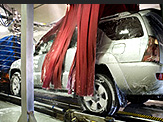The Car Wash Appraisal ProcessModern appraisal theory typically employs
the following three widely accepted methods to develop an opinion of market value.
Unless special circumstances exist, all three
approaches to value are generally utilized in the
appraisal of a car wash facility. More or less weight can be placed on each approach
depending on the strength of the data and/or based
on the investment motivations and criteria of typical buyers and sellers
in the marketplace.
 Cost
Approach
Cost
ApproachThe Cost Approach is based on the
principle that market participants relate cost to
value. In the Cost Approach, the value of a property is derived by adding the estimated value of the
underlying land
to the current cost of constructing a similar facility, and then
subtracting the amount of accrued depreciation in the structures and equipment.
We have appraised over 50 proposed car wash
facilities located throughout the nation, and have
the luxury of having the actual construction cost
information
for each individual facility. This data allows us
to provide realistic estimates of current
replacement costs and equipment costs for various
types of facilities. In addition,
our data serves as an excellent "test of
reasonableness" in comparison with the construction
costs quotes for currently proposed facilities.
 Sales
Comparison Approach
Sales
Comparison ApproachThe Sales
Comparison Approach to value is based upon
comparison of the subject car wash with known sales
of similar facilities. Recent car wash facility sales are analyzed and compared based upon an
overall price basis, price per bay (typically
self-service), or by price per square foot.
Appropriate adjustments are then made for
dissimilarities between the subject property and the
comparable sales to derive a market value
indication. It is important to note that typical
buyers/sellers of car wash facilities place only
limited reliance on these physical aspects of the
property (i.e. price per square foot).
If financial and operating data of the comparables
sales is known, Gross Income (GIM) and EBITDA
multipliers can be extracted and used to estimate
the market value of the subject. GIM and EBITDA
multipliers are generally more reliable when valuing
a car wash due to the fact that they represent the
actual income of the subject property.
Car
washes are income producing properties that are generally not sold if operating at market levels. Therefore, locating viable comparable sales can be difficult. In order to determine market values via the Sales Comparison Approach,
Car Wash Valuation Advisors has back searched and
verified over 2,000 carwash facilities
to locate recent sales.
 Income
Approach
Income
ApproachThe Income
Capitalization Approach is the method most commonly employed by car
wash operators and investors, as it estimates market
value based on the actual earnings capacity of the
facility.
In the Income Approach, we
typically analyze both historic and projected gross incomes,
including the effects of wash package pricing, local market
competition, roadway traffic counts (AADT),
penetration/capture rates, property access and
visibility, along with local demographic statistics. Following the income
analysis is an investigation of both historic and
projected expenses, which develops an estimate of
stabilized EBITDA/NOI. Income and expense information is
generally measured against comparable car wash facilities as an
additional test of reasonableness.
Once a
stabilized estimate of EBITDA/NOI is developed, a
value indication can be obtained by using an
appropriate capitalization rate. Capitalization
rates are typically extracted from comparable car
wash facility sales, and can be measured against
information provided by secondary sources as an
additional test of reliability.